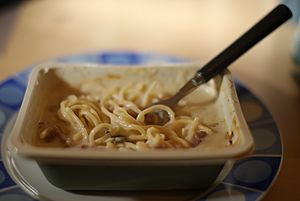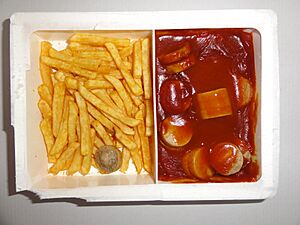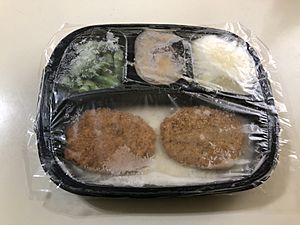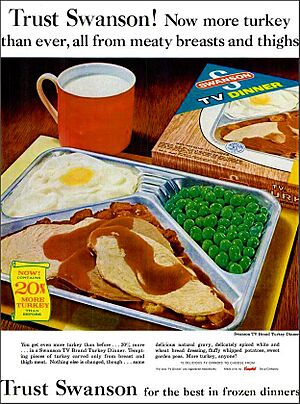Frozen meal facts for kids
A frozen meal is a meal that is already prepared and then frozen. It's made for one person to eat. People call these meals by different names, like TV dinner (in Canada and the US), ready meal (in the UK), or microwave meal. In the United States and Canada, a frozen meal often has a main dish like meat, fish, or pasta. It might also come with vegetables, potatoes, or even a dessert. You can find frozen meals with flavors from all over the world, like Indian, Chinese, or Mexican food.
The name TV dinner became popular because of a brand of packaged meals created in 1953 by a company called C.A. Swanson & Sons. The first TV Dinner came in an aluminum tray. You would heat it in an oven. Today, most frozen food trays are made of plastic or coated cardboard that can be heated in a microwaveable oven. This makes them easy to use and throw away.
Contents
How Did Frozen Meals Start?
Even though some smaller companies made frozen dinners earlier, Swanson was the first to become very successful. The first Swanson TV Dinner was made in the United States. It was like a Thanksgiving meal with turkey, cornbread stuffing, frozen peas, and sweet potatoes. It came in a tray, similar to those used for airplane food. Each food item had its own section.
These trays were very helpful! You could take the whole dinner out of its box, heat the tray directly in the oven without needing other dishes, and then eat right from the tray. The first TV Dinner cost 98 cents. About 5,000 of them were made in the first batch.
Who Invented the TV Dinner?
The name "TV dinner" was thought up by Gerry Thomas. He is often called the inventor. Thomas said that televisions were seen as "magic" and special back then. He believed the name "TV dinner" would make the convenient food seem more exciting. Another idea is that the TV dinner box was designed to look like a television. Soon after, special folding tables called "TV trays" became popular.
The idea of frozen dinners wasn't completely new. In 1944, William L. Maxson's frozen meals were already being served to soldiers and on airplanes. Other pre-made meals were sold before Swanson's TV Dinner. In 1948, "dinner plates" with a main course, potato, and vegetable were sold. In 1952, the first frozen dinners in oven-ready aluminum trays were introduced by Quaker State Foods.
Swanson, a large company that made canned and frozen poultry, helped frozen dinners become very popular. They used their well-known brand name and a big national advertising plan. The clever name "TV Dinner" connected with people's excitement about television.
How Frozen Dinners Changed Over Time
Many things have changed since the first TV dinners were sold. Now, there are many more main dishes, like fried chicken, spaghetti, and Salisbury steak. Other companies, like Banquet and Morton, also started selling their own frozen dinners.
Here are some other changes:
- In 1960, Swanson added desserts, like apple cobbler, to their meals.
- In 1969, the first Swanson TV breakfasts were sold.
- In 1973, Swanson started selling "Hungry-Man" dinners. These had bigger portions.
- In 1986, the first trays that were safe for microwave ovens were introduced.
Today, most frozen dinners come in microwave-safe containers. They are stored in the freezer at the store. To make them, you usually just remove or vent the plastic cover and heat the meal in a microwave for a few minutes. They are very convenient because they need almost no preparation time.

In the United Kingdom, prepared frozen meals became widely available in the late 1970s. They grew in popularity as more people got home freezers and microwave ovens. Also, more people living alone helped increase sales of these convenience foods. In 2003, the UK spent a lot of money on ready meals, becoming the biggest consumer in Europe.
There are also chilled ready meals that are not frozen. They are kept cold and take less time to reheat. These are meant to be eaten soon after buying. Many different kinds of frozen and chilled ready meals are available today. These include "gourmet" recipes, organic and vegetarian dishes, and even smaller meals for children.
How Frozen Meals Are Made
Making frozen meals is a very automated process with three main steps: preparing the food, loading it into trays, and freezing it.
Preparing the Food
First, vegetables and fruits are usually washed on a moving belt. Then, they are steamed or boiled for a short time, usually 1 to 3 minutes. This process is called blanching. It helps to stop enzymes in the food that can change its flavor and color. For meats, they are trimmed of fat and cut into the right sizes before cooking. Fish is cleaned and cut into pieces, and poultry is washed well. Meats are then seasoned, placed on trays, and cooked in an oven.
Loading and Freezing
After all the food is cooked, it goes to the filling lines. The food is placed into its sections in the trays as the trays move under many filling machines. These machines are carefully controlled to make sure each dinner gets the same amount of food.
The food is then frozen very quickly using liquid nitrogen. This is called cryogenic freezing. As the food moves on a conveyor belt, it is sprayed with liquid nitrogen, which boils when it touches the food. This fast freezing method helps keep the food's natural quality. When food is frozen this way, tiny ice crystals form inside it. This can preserve the food for a very long time if stored correctly. Cryogenic freezing is used because it's fast, causes almost no drying out, keeps oxygen away (which stops spoilage), and causes less damage to the food pieces.
Packaging and Storage
After freezing, the dinners are covered with aluminum foil or paper. The product is packed tightly, sometimes with a partial vacuum, to make sure no moisture escapes and the food doesn't dry out. Then, the packaged dinners are stored in a refrigerated facility, moved by refrigerated trucks, and kept in the freezer section of grocery stores. If frozen and packaged correctly, TV dinners can stay in good condition for a long time, as long as they are stored at about -18°C (0°F) during shipping and storage.
Are Frozen Meals Healthy?
Frozen meals are often processed with extra salt and fat. This helps them last longer. Also, to keep the food stable for a long time, companies might use certain oils, especially for desserts. These oils can contain trans fats, which are not good for your heart health. Frozen dinners are usually less nutritious than fresh food. They often contain preservatives, like butylated hydroxytoluene, to keep them edible for a long time. However, how healthy they are can vary between different brands.
In recent years, many companies and stores have started making frozen meals that are lower in salt and fat and do not have artificial additives. In the UK, most supermarkets now have their own "healthy eating" brands. Almost all chilled or frozen ready meals sold in the UK now have clear labels showing the salt, sugar, and fat content. Concerns about obesity and public health campaigns have encouraged manufacturers to reduce the levels of salt and fat in ready-prepared food.
See also
- Banquet Foods
- Bento
- Freezer Queen
- Swanson
- Frozen pizza
- Field ration




